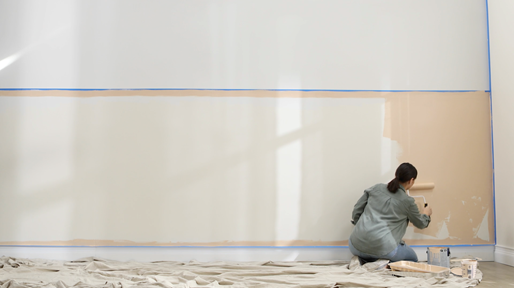Actual color may vary from on-screen representation.
EXPERT TIP #1: CUTTING IN
EXPERT TIP #2: MAINTAIN A WET EDGE
This tip goes hand-in-hand with cutting in - by keeping a wet edge you’ll make sure your paint brushing and paint rolling look the same. To do this, it’s wise to work on one wall at a time. After cutting in, take a roller to apply paint over the brush strokes. You’ll want to make sure you keep the roller about an inch or more away from the cut-in edge. Doing this will not only smooth out any paint strokes, but also match the stippling, or texture, that your final rolled wall will have.

EXPERT TIP #3: LADDER SUPPORT
Most people don’t think twice about climbing a ladder to paint, but how you use your ladder can make a difference in your safety and fatigue.
When you climb a ladder to paint, make sure your chest is being supported by the ladder as you lean in to paint. Otherwise, you risk losing your balance or causing unneeded strain.
EXPERT TIP #4: LOADING/WIPING YOUR BRUSH
Having the right amount of paint on your brush will save you from having to make too many trips to the paint bucket. When dipping – also called loading – your brush, dip it about 1/3 of the way in. Remove the brush and gently wipe off the excess paint by running it across the inside edge of your can or bucket. If using a paint can, be sure to avoid doing this on the top rim, as it will make a mess when closing your lid. Do this twice to make sure you have enough paint, and remember – a properly loaded brush will not drip.

EXPERT TIP #6: PAINT BRUSH STORAGE
Proper care of your brushes will allow you to use them for multiple projects. After cleaning your brushes and letting them dry, you can use the original packaging to help keep the bristles straight. Then they’ll be ready to go for your next project. See the cleanup how-to article for more info on how to properly store your tools.


